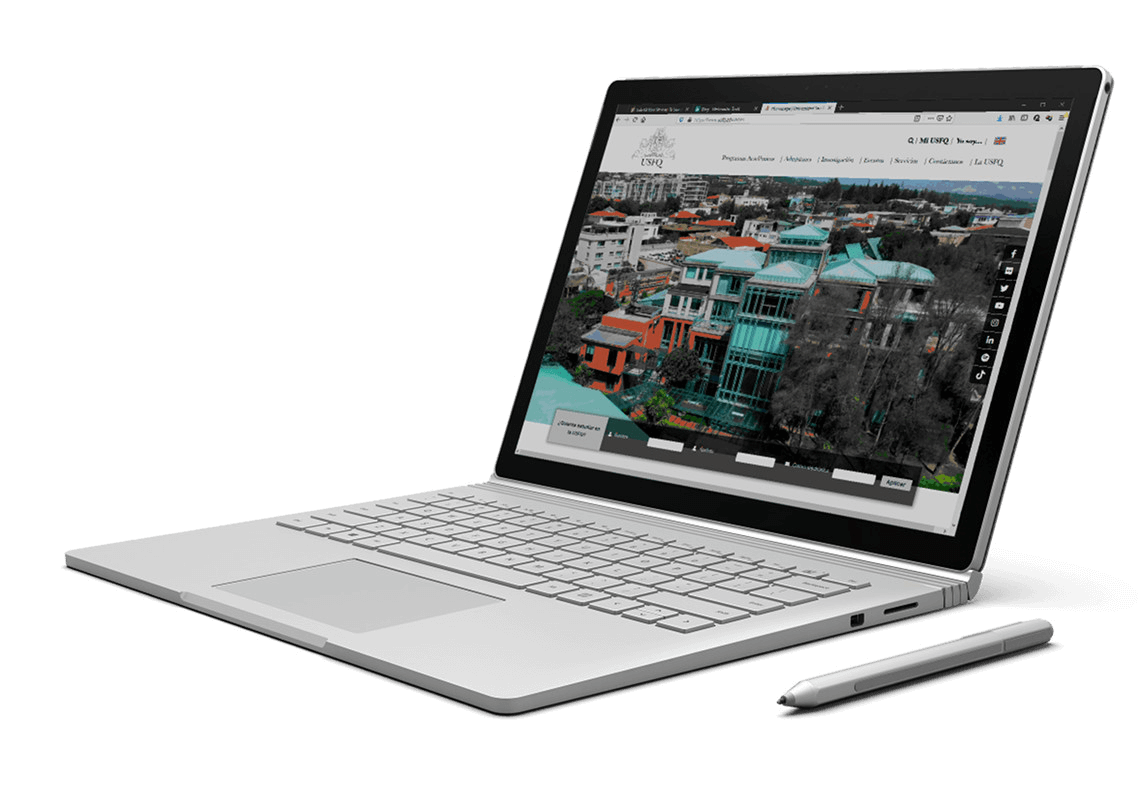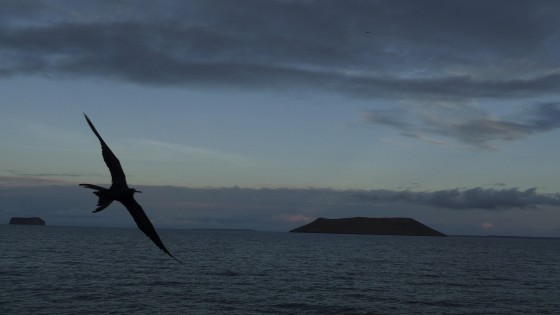Quitel 2014
CALL
The XL Congress of Theoretical Chemists of the Latin Expression QUITEL 2014 will take place in the San Cristóbal Island, Ecuador from November 23 to November 30, 2014.
This edition of the congress will provide an appropriate environment to:
Review the most recent advances in the theoretical and computational chemistry field
Communicate by short presentations and posters the work conducted by students and young scientists, and
Generate scientific collaborations between the participants of the congress.
The Organizing Committee is pleased to invite the scientists of Latin America, Europe and the Entire World to be part of this event and to enjoy an unforgettable experience in the Enchanted Islands.
On behalf of the Organizing Committee:
F. Javier Torres, Ph.D.
Chair of the Committee
Registration Fee
Early Inscription
Before April 30th, 2014
Professionals 360.00 USD
Students 290.00 USD
Regular Inscription
After May 1st, 2014
Professionals 410.00 USD
Students 340.00 USD
ACCOMMODATION
Hotel PRICE*
Simple Room Double Room
Northia 531.00 USD 504.00 USD
(Additional Night) 54.00 USD 50.00 USD
Chatham 736.00 USD 620.00 USD
(Additional Night) 83.00 USD 67.00 USD
ArenaBlanca 958.00 USD 647.00 USD
(Additional Night) 115.00 USD 71.00 USD
Miconia 1056.00 USD 985.00 USD
(Additional Night) 129.00 USD 119.00 USD
*Listed price includes 7 nights + breakfastper person
OPTIONAL EXCURSIONS
| Activity | Descrition | Cost |
|---|---|---|
| A. Isla Lobos y Playa Ochoa |
Isla Lobos: it is a small island where you can observe seals, blue-footed boobies, large frigates, pelicans, lava gulls. Playa Ochoa: it is a beautiful beach, with calm waters, where it is safe to swim and snorkel. |
80.00 USD |
| B. Laguna del Juno y Galapaguera |
Laguna del Junco: it is the only lagoon of permanent fresh water in the Galápagos. Located on the top of San Cristóbal, at an altitude of 700 meters. La Galapaguera: it consists on a small population of giant turtles that can be observed in their natural habitat. |
54.00 USD |
| C. La Lobería | La Lobería: it is the home of a large colony of sea lions where you can observe the mothers teaching their offspring how to swim. | 30.00 USD |
| D. Cerro tijeretas | Cerro tijeretas: it is a unique place where you can appreciate two different species of frigates | 30.00 USD |
FLIGHT RESERVATION
The reservation of the flight: Quito-San Cristóbal-Quito or Guayaquil-San Cristóbal-Guayaquil will have an approximate cost of 550 USD. This price can vary depending on availability and the date of reservation.
ACCOMPANYING PERSONS
People accompanying participants do not need to pay the inscription fee, but they must pay the accommodation costs and the flight reservation.
PAYMENT
Options:
- Payment with an international credit card
- International wire transfer
To obtain more details about the payment options, please contact directly Condor Travel Ecuador.
Email: ventas-ecuador@condortravel.com
Phones: +593 2 331 9696
+593 2 226 1875
Skype: condortravelecuador
Program and Participants
Program
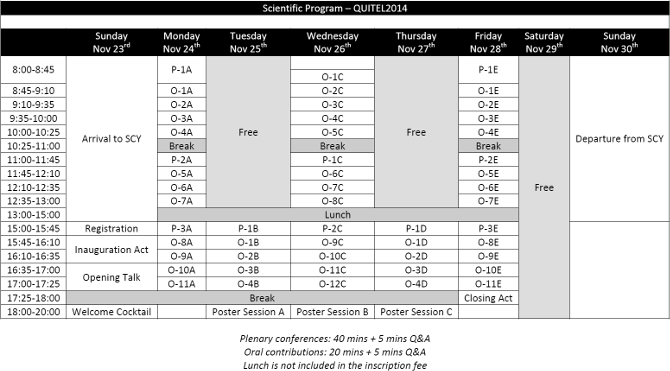
Download File
PLENARY SPEAKERS
- Alan Aspuru-Guzik / Harvard University (USA)
- Alfredo Alexander-Katz / MIT (USA)
- Kaline Coutinho / Universidade de Sao Paulo (Brasil)
- Davide Ceresoli / Centro Nzionale della Ricerca (Italia)
- Pedro Fernandes / Universidad de Porto (Portugal)
- Mario Piris / Universidad del País Vasco (España)
- Todd Martínez / Standford (USA)
- Oscar Malta / Universidade Federal de Pernambuco (Brasil)
- Tung Nguyen-Dang / University of LAVAL (Canada)
- Eduardo V. Ludeña / IVIC (Venezuela)
- Vladimiro Mujica / Arizona State University (USA)
LIST OF CONFIRMED PARTICIPANTS
- Alessandra Albernaz / Universidade de Brasília (Brasil)
- Marta Erminia Alberto / Università della Calabria (Italia)
- Joel Alderete / Universidad de Concepción (Chile)
- Luis Alvarez Thon / Universidad Andrés Bello (Chile)
- Nina Arguello / Grupo de Química Computacional y Teórica (Ecuador)
- Luis Arnaut / University of Coimbra (Portugal)
- Ramiro Arratia / Universidad Andrés Bello (Chile)
- Ana Arrieta / Universidad del Pais Vasco UPV/EHU (España)
- Alan Aspuru-Guzik / Harvard University (USA)
- Osman Atabek / CNRS (Francia)
- David Azevedo / Universidade de Brasilia - UnB (Brazil)
- Leonardo Baptista / Universidade do Estado do Rio de Janeiro (Brasil)
- Isabelle Baraille / PREM (UMR 5624) Université de pau et des pays de l'Adour (Francia)
- Pabla Andrea Barra Oliva / Universidad de Concepción (Chile)
- Daniela Barragán / Escuela Superior Politécnica de Chimborazo (Ecuador)
- Luz Barreto / Universidad San Francisco de Quito (Ecuador)
- Marcos Becerra / Grupo de Química Computacional y Teórica (Ecuador)
- Virineya Sonia / Bertin Mardel Universidad Autónoma Universitaria Iztapalapa (México)
- Marzio Bettega / Universidade Federal do Parana (Brasil)
- Martin Blood-Forsythe / Harvard University (USA)
- Roberto Bochicchio / Universidad de Buenos Aires (Argentina)
- Pierre Bonifassi / Le Mans university (Francia)
- Natércia Bras / REQUIMTE/Faculdade de Ciências, Universidade do Porto (Portugal)
- Joana Bustamante / Universidad Técnica Particular de Loja (Ecuador)
- Ana Cadena / Grupo de Química Computacional y Teórica (Ecuador)
- Paloma Calle / Universidad Autónoma de Madrid (España)
- Sylvio Canuto / Universidade de São Paulo (Brasil)
- Carlos Cárdenas / Universidad de Chile (Chile)
- Anderson Catão / Universidade Estadual de Goiás (Brasil)
- Robert Cazar / Escuela Superior Politécnica de Chimborazo (Ecuador)
- Davide Ceresoli / CNR-ISTM (Italia)
- María Alejandra / Checa Universidad Nacional de Tucuman (Argentina)
- Henry Chermette / Université Lyon1 (Francia)
- Diego Cortés / Pontificia Universidad Catolica de Chile (Chile)
- Fernando Cossio Mora / Universidad del País vasco (UPV/EHU) (España)
- Tanos Costa Franca / Military Institute of Engineering (Brasil)
- Kaline Coutinho / Universidade de São Paulo (Brasil)
- Raphael da Silva Affonso / Instituto Militar de Engenharia (Brasil)
- Gabriel de Souza / Universidade Federal de Mato Grosso (Brasil)
- Eduardo Delgado Ramírez / Universidad de Concepción (Chile)
- Alexandra Deriabina / Benemédita Universidad Autónoma de Puebla
- Silvia Díaz / Pontificia Universidad Catolica de Chile (Chile)
- Antonio Díaz / Universidad Yachai (Ecuador)
- Helio Duarte / Universidade Federal de Minas Gerais (Brasil)
- Geraldo Magela / E Silva Instituto de Física (Brasil)
- Bernhard Georg / Enders University of Brasilia (Brasil)
- Alessandro Erba / Universita degli Studi di Torino (Italia)
- Jairo Escobar / Universidad Técnica Particular de Loja (Ecuador)
- Felipe Fantuzzi / Universidade Federal do Rio de Janeiro (Brasil)
- Pedro A. Fernandes / Universidade do Porto (Portugal)
- Sebastian Fernández / Universidad Nacional de Quilmes (Argentina)
- Marta Ferraro / Universidad de Buenos Aires (Argentina)
- Martin Field / Institut de Biologie Structurale (Francia)
- Antonio Luciano / Fonseca / University of Brasilia (Brasil)
- Antonio Frances Monerris / Universitat de València (España)
- Héctor Isaí Francisco / Universidad Autónoma Metropolitana (México)
- Patricio Fueteaba / Universidad de Chile (Chile)
- José Manuel García / Universidad Autónoma de Madrid (España)
- Daniela Geraldo / Universidad Andrés Bello (Chile)
- Lorena Gerli / Universidad Catolica de la Santiisima Concepcion (Chile)
- Marcos Gomes / Eleuterio Universidade Federal do Paraná (Brasil)
- Lauriane Gomes Santin / Universidade de Brasília (Brasil)
- Sara Gómez / Universidad de Antioquia (Colombia)
- Silvia González Pérez / Universidad Técnica Particular de Loja (Ecuador)
- José Granadino / Universidad de Jaén (España)
- Gueorgui Gueorguiev / Linkoping University (Suecia)
- Daniela Guzmán-Angel / Pontificia Universidad Católica de Chile (Chile)
- Erendida Hernández Vera / Universidad Autónoma Metropolitana-Iztapalapa (México)
- Barbara Herrera / Pontificia Universidad Católica de Chile (Chile)
- Francesc Illas / Universitat de Barcelona (España)
- Ricardo Inostroza / Pontificia Universidad Católica de Chile (Chile)
- Rafael Islas / Universidad Andrés Bello (Chile)
- Anelia Kakanakova / Linköping University (Suecia)
- Alexander Katz / Massachusetts Institute of Tchnology (USA)
- Luis Lain / Universidad del Pais Vasco (España)
- Begoña Lecea Arana / Universidad del Pais Vasco UPV/EHU (España)
- Roland Lefebvre / Institut des Sciences Moleculaires d'Orsay (ISMO) (Francia)
- Claude Leforestier / Université Montpellier 2 (Francia)
- Thierry Leininger / Laboratoire de Chimie et Physique Quantiques Université Toulouse 3 (Francia)
- Sandra Llano / Universitaria Lasallista (Colombia)
- Anderson Lopez Catão / Universidade Estadual de Goiás (Brasil)
- Eduardo Ludeña / Universidad Yachai (Ecuador)
- Cristina Luga / Universidad Autónoma Metropolitana Xochimilco (México)
- Alexandre Magalhães / Requimte/Universidade do Porto (Portugal)
- Oscar Malta / Universidade Federal de Pernambuco
- Liliana Mammino / University of Venda (Sudafrica)
- Todd Martinez / Stanford University (USA)
- Alejandro Martiz / Escuela Superior Politécnica del Litoral (Ecuador)
- Miguel Angel Mendez / Grupo de Química Computacional y Teórica (Ecuador)
- Guillerme Menengon / Universidade de Sao Paulo (Brasil)
- Viviana Monje-Galvan / University of Maryland-College Park (USA)
- Fábio Monteiro / Universidade de Brasília - Instituto de Física (Brasil)
- José Mora / Instituto Venezolano de Investigaciones Cientificas (Venezuela)
- Silvia Morante / University of Rome 2 (Italia)
- Vladimiro Mujica / Arizona State University (USA)
- Juliana Murillo / Universidad Andrés Bello (Chile)
- Karen Roxana / Navarrete Universidad de Concepción (Chile)
- Oracio Navarro / Universidad Nacional Autónoma de México (México)
- Thanh-Tung Nguyen-Dang / Université Laval (Canada)
- Rafael Notario Bueno / Instituto de Química Física "Rocasolano", CSIC (España)
- Valeria Ochoa-Herrera / Universidad San Francisco de Quito (Ecuador)
- Ofelia Oña / Instituto de Investigaciones Fisicoquímicas Teóricas y Aplicadas - CONICET (Argentina)
- Michelle Oña / Grupo de Química Computacional y Teórica (Ecuador)
- Jorge Eduardo Ontaneda-Rojas / University of Reading (UK)
- Daniela Ortega / Pontificia Universidad Católica de Chile (Chile)
- Emilce Ottavianelli / Universidad Nacional de Salta (Argentina)
- Dayán Páez Hernández / Universidad Andrés Bello (Chile)
- Juliana Palma / Universidad Nacional de Quilmes (Argentina)
- Ricardo Paredes / Proyecto Prometeo (Ecuador)
- Laura Pedraza / Universidad Nacional de Colombia (Colombia)
- Juan E. Peralta / Central Michigan University (USA)
- Bolívar Andrés / Pérez González Universidad del Azuay (Ecuador)
- Daniela Pickholz / Universidad de Buenos Aires (Argentina)
- Gustavo Pierdominici / Universidad Nacional de Quilmes (Argentina)
- Mario Piris / Universidad del Pais Vasco UPV/EHU (España)
- Victor Posligua / Grupo de Química Computacional y Teórica (Ecuador)
- Gabriela Possa / Universidade de Brasilia (Brasil)
- Walter Rabanal / Universidad Andrés Bello (Chile)
- Maria Joao Ramos / REQUIMTE/Faculdade de Ciências, Universidade do Porto (PT)
- Jean Claude Rayez / University of Bordeaux (Francia)
- Misael Real Enriquez / Grupo de Química Computacional y Teórica (Ecuador)
- Andres Reyes / Universidad Nacional de Colombia (Colombia)
- Daniel Roca Sanjuán / Universitat de València (España)
- Alexandre Rocha / Universidade Federal do Rio de Janeiro (Brasil)
- Breno Rodrigues Lamaghere / Centro Federal de Educacão Tecnológica de Minas Gerais, CEFET-MG (Brasil)
- Carlos Rodríguez / Grupo de Química Computacional y Teórica (Ecuador)
- Natalia Andrea / Rojas Valencia Universidad de Antioquia (Colombia)
- Luiz Roncaratti / Universidade de Brasilia (Brasil)
- Marzio Rosi / Universita de Perugia
- Giancarlo Rossi / University of Rome 2 (Italia)
- Jaime Rubio Martínez / University of Barcelona (España)
- Roxana Rudyk / Universidad Nacional de Tucumán (Argentina)
- Nino Russo / Università della Calabria (Italia)
- Ignacio Sainz-Díaz / Instituto Andaluz de Ciencias de la Tierra (España)
- Edison Salazar / CEAACES (Ecuador)
- Andrés Salazar / Grupo de Química Computacional y Teórica (Ecuador)
- Samantha Samaniego / Escuela Superior Politécnica del Litoral (Ecuador)
- Solemar Silva Oliveira / Universidade de Goiás (Brasil)
- Jean-Christophe Soetens / Universite de Bordeaux, CNRS (Francia)
- Jean-Marc Sotiropoulos / Université de Pau et des Pays de l'Adour (Francia)
- Jonathan Teixeira / Federal Institute of Brasilia (Brasil)
- Alicia Torre / Universidad del Pais Vasco (España)
- Francisco Torrens / Universitat de Valencia (España)
- Jorge Ali Torres / Universidad Nacional de Colombia (Colombia)
- F. Javier Torres / Grupo de Química Computacional y Teórica (Ecuador)
- Andrés Urbina / Grupo de Química Computacional y Teórica (Ecuador)
- Sara Vaca / Escuela Superior Politécnica de Chimborazo (Ecuador)
- Stephanie Valleau / Harvard University (USA)
- Antonio Varandas / Universidade de Coimbra (Portugal)
- Marcio Varella / University of São Paulo (Brasil)
- Alejandro Vásquez-Espinal / Universidad Andres Bello (Chile)
- Carlos Vieira de Moura / Universidade Federale de Rio de Janeiro (Brasil)
- Juvenal Yosa / University of Basel (Suiza)
- Cesar Zambrano / Universidad San Francisco de Quito (Ecuador)
Committees
LOCAL ORGANIZING COMMITTEE
F. Javier Torres, Ph.D. (chair)
Grupo de Química Computacional y Teórica (QCT-USFQ), Universidad San Francisco de Quito (USFQ)
Grupo Ecuatoriano para el Estudio Experimental y Teórico de Nanosistemas –GETNano–
Cesar H. Zambrano, Ph.D.
Grupo de Química Computacional y Teórica (QCT-USFQ), Universidad San Francisco de Quito (USFQ)
Grupo Ecuatoriano para el Estudio Experimental y Teórico de Nanosistemas –GETNano–
Miguel A. Mendez, Ph.D.
Grupo de Química Computacional y Teórica (QCT-USFQ), Universidad San Francisco de Quito (USFQ)
Grupo Ecuatoriano para el Estudio Experimental y Teórico de Nanosistemas –GETNano–
Dennis Cazar, Ph.D.
Grupo de Química Computacional y Teórica (QCT-USFQ), Universidad San Francisco de Quito (USFQ)
Grupo Ecuatoriano para el Estudio Experimental y Teórico de Nanosistemas –GETNano–
INTERNATIONAL SCIENTIFIC COMMITTEE
Eduardo V. Ludeña (chair)
Centro de Química, Instituto Venezolano de Investigaciones Científicas (IVIC), Caracas, Venezuela
Grupo Ecuatoriano para el Estudio Experimental y Teórico de Nanosistemas -GETNano-, Quito, Ecuador
Alan Aspuru-Guzik
Department of Chemistry and Chemical Biology at Harvard University. Boston, USA
Osman Atabek
French National Centre for Scientific Research - Institut des Sciences Moléculaires d´Orsay (ISMO). Paris, Francia
Sylvio Canuto
Molecular Physics and Modelling - Instituto de Física da Universidade de São Paulo. Sao Paulo, Brazil
Marco Antonio Chaer Nascimento
Departamento de Físico-Química - Instituto de Química, Universidade Federal do Rio de Janeiro. Rio de Janeiro, Brazil
Lorenzo Echevarría
Departamento de Química, Universidad Simón Bolívar (USB). Caracas, Venezuela
Patricio Fuentealba
Departamento de Física - Facultad de Ciencias. Universidad de Chile. Santiago, Chile
José Manuel García de la Vega
Departamento de Química Física Aplicada - Facultad de Ciencias. Universidad Autónoma de Madrid. Madrid, España
Carlo Gatti
CNR-ISTM (Istituto di Scienze e Tecnologie Molecolari) - Physical Chemistry and Electrochemistry, Università degli Studi di Milano. Milano, Italia
Anwar Hasmy
Departamento de Física -Universidad Simón Bolívar. Caracas, Venezuela
Francesc Illas
Departament de Química Física & Institut de Quimica Teorica i Computacional (IQTCUB) - Universitat de Barcelona. Barcelona, España
Jean Paul Malrieu
Laboratoire de Chimie et Physique Quantiques - Université Paul Sabatier. Toulouse, Francia
Vladimiro Mujica
Department of Chemistry & Biochemistry ASU College of Liberal Arts and Science. Phoenix, USA
Cristina Puzzarini
Dipartimento di Chimica - Università di Bologna. Bologna, Italia
Maria Joao Ramos
Chemistry Department, Faculty of Sciences. University of Porto. Porto, Portugal
Andres Reyes
Grupo de Química Cuántica y Computacional - Departamento de Química, Universidad Nacional de Colombia. Bogotá, Colombia
Adrian Roitberg
Quantum Theory Project, Department of Chemistry - University of Florida. Gainsville, USA
Orlando Tapia
Department of Chemistry, Ångström Laboratory - Uppsala University. Uppsala, Suecia
Alejandro Toro-Labbé
Laboratorio de Química Teórica Computacional - Pontificia Universidad Católica de Chile. Santiago, Chile
Jesus Ugalde
Kimika Fakultatea - Euskal Herriko Unibertsitatea. Donostia, España
Antonio Varandas
Theoretical & Computational Chemistry - Universidade de Coimbra. Coimbra, Portugal
Alberto Vela
Departamento de Química - CINVESTAV. Ciudad de México, México
Cesar Zambrano
Grupo de Química Computacional y Teórica (QCT-USFQ), Universidad San Francisco de Quito (USFQ)
Grupo Ecuatoriano para el Estudio Experimental y Teórico de Nanosistemas –GETNano–. Quito, Ecuador
Julie Nieto
Facultad de Investigación y Posgrado - Escuela Superior Politécnica del Litoral (ESPOL). Guayaquil, Ecuador
History
The idea of organizing the QUITEL initiated in Prof. Pullman’s office, located on the 3rd floor of the Physical-Chemical Biology Institute of Paris during a friendly conversation between the professors Pullman and Giuseppe Del Re. The topic of discussion was the role of Theoretical Chemistry in Italy, France and other countries such as the United Kingdom and the United States.
Apparently, the theorists where more interested in the meaning of the numeric results to associate them to physical-chemical phenomena, than in the numbers themselves. Nevertheless, the need to develop the underlying physics to such numbers concisely, overcoming the linguistic barrier, became a problem that needed to be resolved. The alternatives were: adopt a not complex language, accessible to all, or maintain each investigator’s language, increasing the fluency of the expression of ideas, but taking the risk to reduce the comprehension of the participants whose native languages wouldn’t be the same as the speaker. And the end, it was decided that this was not a problem, as in terms of scientific matter, the words in Latin languages, whether written or spoken, are so close one to another that there should not be any problem as long as people speak slowly and clearly. Therefore, the idea of reuniting French and Italian theorists, whose organization was proposed by the Prof. Del Re (Italy), along with his collaborators F. Momicchioli, A. Rastelli, B. Cadioli and L. Pincelli, came up.
The first encounter was set to occur in 1968, but due to the political issues of that time, it was postponed to 1969. The participants were satisfied with the initiative, and they agreed for a next reunion in France, with the participation of the Prof. Daudel and his Spanish colleagues, who also joined the reunion in 1970. After this encounter, the QUI(CHI)TEL took place in Granada, Spain (1971). From that moment, the Profs. Y. G. Smeyers and J. I. Fernández Alonso became active members of the international scientific committee. In 1974, Latin America joined the QUITEL (congress of Morelia, Mexico) and later, the northern countries of Africa joined as well. From 2003, the celebration of the QUITEL is alternated between Europe, Africa and Latin America.
PREVIOUS EDITIONS OF QUITEL
| EDITION | YEAR | CITY (COUNTRY) | ORGANIZER |
|---|---|---|---|
| 1 | 1969 | Modena (ITA) | Fabio Momicchioli |
| 2 | 1970 | Paris (FRA) | Alberte Pullman Bernard Pullman |
| 3 |
1971 | Granada (SPA) | J.I. Fernández-Alonso |
| 4 | 1972 | Cortona (ITA) | Eolo Scrocco Oriano Salvetti |
| 5 | 1974 | Morelia (MEX) | Raúl Cetina |
| 6 | 1975 | Arlés (FRA) | André Julg |
| 7 | 1976 | Wepion (BEL) | Jean Marie Andre Georges Leroy Raymond Daudel |
| 8 | 1977 | Salamanca (SPA) | Miguel Angel Herraez Zarza Yves Smeyers |
| 9 | 1978 | Stresa (ITA) | Enrico Clementi |
| 10 | 1979 | Géneve (SWI) | Jacques Weber |
| 11 | 1980 | Pau (FRA) | Max Chaillet |
| 12 | 1981 | Barcelona (SPA) | Ramón Carbó-Dorca |
| 13 | 1982 | Alghero (ITA) | Massimo Simonetta |
| 14 | 1983 | Louvain (BEL) | Georges Leroy Daniel Peeters |
| 15 | 1984 | Viana do Castelo (POR) | José Ferreira Gomes |
| 16 | 1986 | Lyon (FRA) | C. Barbier-Chapelet M. Frecon H. Chermette |
| 17 | 1987 | Peñíscola (SPA) | J.I. Fernández-Alonso F. Tomas Vert |
| 18 | 1989 | La Plata (ARG) | Eduardo Castro |
| 19 | 1990 | Roma (ITA) | M. Cignitti M. Bossa Franco Gianturco |
| 20 | 1992 | Mérida (VEN) | Eduardo Ludeña Wilmer Olivares |
| 21 | 1993 | Grenoble (FRA) | A. Grand R. Subra |
| 22 | 1995 | Pucón (CHI) | Alejandro Toro-Labbe |
| 23 | 1996 | Cáceres (SPA) | Francisco Olivares del Valle |
| 24 | 1998 | Puebla (MEX) | Alejandro Palma |
| 25 | 1999 | Napoli (ITA) | Vincenzo Barone |
| 26 | 2000 | Caxambu (BRA) | Marco Antonio Chaer Nascimento |
| 27 | 2001 | Toulouse (FRA) | Daniel Maynau |
| 28 | 2002 | Montevideo (URU) | Oscar Ventura |
| 29 | 2003 | Marrakech (MAR) | M'hammed Esseffar |
| 30 | 2004 | Porto (POR) | Maria Joao Ramos |
| 31 | 2005 | Isla Margarita (VEN) | Fernando Ruette |
| 32 | 2006 | Côtes de Carthage (TUN) | Bahoueddine Tangour |
| 33 | 2007 | La Habana (CUB) | Luis A. Montero |
| 34 | 2008 | Cetraro (ITA) | Nino Russo |
| 35 | 2009 | San Andrés(COL) | Andrés Reyes |
| 36 | 2010 | Anglet (FR) | Claude Pouchan Philippe Carbonnière |
| 37 | 2011 | Riviera Maya (MEX) | Gabriel Merino Alberto vela |
| 38 | 2012 | Natal (BRA) | Élson Longo Julio R. Sambrano |
| 39 | 2013 | Granada (SPA) | Alfonso H. Laguna |
Ecuadorand and the Galapagos
Ecuador and the Galapagos
Ecuador is the perfect synonym for diversity. Discover this fabulous mix of landscapes, climates, ecosystems and cultures, all in a small territory, similar to the surface of the United Kingdom or the state of Colorado in the U.S.A. Here, in a matter of minutes by air, you can move quickly between the Pacific coast, the Andean highlands, the Amazon and the Galapagos Islands. These are the four worlds of Ecuador, all in one fascinating and welcoming country; a colorful universe of variety and pure magic.
Galapagos Islands
Located in the Pacific Ocean, 1000 kilometers from the mainland of South America, this Ecuadorian archipelago, composed of 14 major islands and more than 60 smaller islands and islets, surrounded by its marine reserve, the second largest in the world, is known as a "living laboratory" or "showcase" of evolution.
The combination of converging ocean currents, a volcanic geological structure and its oceanic isolation has resulted in this "melting pot" of unique species found nowhere else in the world. Some of the most notorious examples are marine iguanas, giant tortoises (called "Galapagos") and the 13 varieties of Darwin's finches.
This uniqueness inspired Charles Darwin's theory of evolution after his visit to the islands in 1835. Since then, they have become a mecca for scientific research. Today, as a strictly protected National Park, and the first natural area in the world to be designated a UNESCO World Heritage Site, the Galapagos are also one of the world's most fascinating tourist destinations and a true wonder of nature.
USFQ in Galapagos
The Galapagos campus of the Universidad San Francisco de Quito (which includes the local programs, Gaias, and the GSC) is located on the island of San Cristobal, the capital of the Galapagos Islands, in the town of Puerto Baquerizo Moreno, which has a population of approximately 6,000 people, most of whom make their living primarily from artisanal (small-scale) fishing, and tourism. On San Cristóbal, the water temperature is 22-23 C° / 71-73 F°, although it can vary from 19-26 C° / 66-78 F°. Other islands (such as Hispaniola) have lower water temperatures depending on the time of year.
On San Cristobal, students are surrounded by some of the most unique wildlife on the planet. On this island they will have the opportunity to observe blue-footed boobies, masked boobies, frigate birds, ducklings, coots, pelicans, giant tortoises, sea turtles, crabs, sea lions, and various other marine and land birds, including some species of Darwin's famous finches.
Translated with www.DeepL.com/Translator (free version)
Sponsors
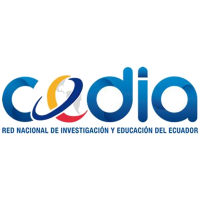 CEDIA (Consorcio Ecuatoriano para el Desarrollo de Internet Avanzado, Ecuadorian Consortium for Advanced Internet Development), is composed by Ecuadorian Universities and Institutions of Research and Development, was created to encourage, promote and coordinate the Project Advanced Networks, development of information technologies, telecommunications and computing networks focused on scientific, technological, innovative and educational development in Ecuador.
CEDIA (Consorcio Ecuatoriano para el Desarrollo de Internet Avanzado, Ecuadorian Consortium for Advanced Internet Development), is composed by Ecuadorian Universities and Institutions of Research and Development, was created to encourage, promote and coordinate the Project Advanced Networks, development of information technologies, telecommunications and computing networks focused on scientific, technological, innovative and educational development in Ecuador.
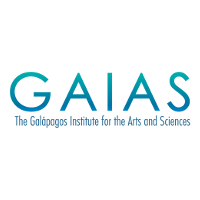 The Galapagos Institute for the Arts and Sciences (GAIAS) is a world-class academic and research institution offering hands-on academic programs for international and Ecuadorian students alike. Students partaking in our semester programs have the opportunity to choose between three tracks: Marine Ecology; Evolution, Ecology and Conservation; and People Politics and the Environment. GAIAS also offers tailor made programs, for faculty led programs by other universities and academic institutions. Established by Universidad San Francisco de Quito (USFQ) in 2002
The Galapagos Institute for the Arts and Sciences (GAIAS) is a world-class academic and research institution offering hands-on academic programs for international and Ecuadorian students alike. Students partaking in our semester programs have the opportunity to choose between three tracks: Marine Ecology; Evolution, Ecology and Conservation; and People Politics and the Environment. GAIAS also offers tailor made programs, for faculty led programs by other universities and academic institutions. Established by Universidad San Francisco de Quito (USFQ) in 2002
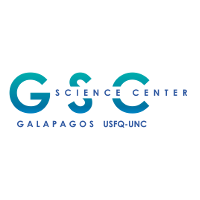 El Galapagos Science Center (GSC), es un centro de investigación multidisciplinario ubicado en la isla San Cristóbal, que ha sido creado gracias a la colaboración entre la Universidad San Francisco de Quito (USFQ) y la Universidad de Carolina del Norte - Chapel Hill (UNC) para el desarrollo científico en las Islas Galápagos.
El Galapagos Science Center (GSC), es un centro de investigación multidisciplinario ubicado en la isla San Cristóbal, que ha sido creado gracias a la colaboración entre la Universidad San Francisco de Quito (USFQ) y la Universidad de Carolina del Norte - Chapel Hill (UNC) para el desarrollo científico en las Islas Galápagos.
Contact
For more information about this event, please contact us at:
F. Javier Torres, Ph.D
Universidad San Francisco de Quito
E-mail: quitel2014@gmail.com
LOCAL ORGANIZING COMMITTEE
F. Javier Torres, Ph.D. (chair)
Grupo de Química Computacional y Teórica (QCT-USFQ), Universidad San Francisco de Quito (USFQ)
Grupo Ecuatoriano para el Estudio Experimental y Teórico de Nanosistemas –GETNano–
Cesar H. Zambrano, Ph.D.
Grupo de Química Computacional y Teórica (QCT-USFQ), Universidad San Francisco de Quito (USFQ)
Grupo Ecuatoriano para el Estudio Experimental y Teórico de Nanosistemas –GETNano–
Miguel A. Mendez, Ph.D.
Grupo de Química Computacional y Teórica (QCT-USFQ), Universidad San Francisco de Quito (USFQ)
Grupo Ecuatoriano para el Estudio Experimental y Teórico de Nanosistemas –GETNano–
Dennis Cazar, Ph.D.
Grupo de Química Computacional y Teórica (QCT-USFQ), Universidad San Francisco de Quito (USFQ)
Grupo Ecuatoriano para el Estudio Experimental y Teórico de Nanosistemas –GETNano–
INTERNATIONAL SCIENTIFIC COMMITTEE
Alan Aspuru-Guzik
Department of Chemistry and Chemical Biology at Harvard University. Boston, USA
Osman Atabek
French National Centre for Scientific Research - Institut des Sciences Moléculaires d´Orsay (ISMO). Paris, Francia
Sylvio Canuto
Molecular Physics and Modelling - Instituto de Física da Universidade de São Paulo. Sao Paulo, Brazil
Marco Antonio Chaer Nascimento
Departamento de Físico-Química - Instituto de Química, Universidade Federal do Rio de Janeiro. Rio de Janeiro, Brazil
Lorenzo Echevarría
Departamento de Química, Universidad Simón Bolívar (USB). Caracas, Venezuela
Patricio Fuentealba
Departamento de Física - Facultad de Ciencias. Universidad de Chile. Santiago, Chile
José Manuel García de la Vega
Departamento de Química Física Aplicada - Facultad de Ciencias. Universidad Autónoma de Madrid. Madrid, España
Carlo Gatti
CNR-ISTM (Istituto di Scienze e Tecnologie Molecolari) - Physical Chemistry and Electrochemistry, Università degli Studi di Milano. Milano, Italia
Anwar Hasmy
Departamento de Física -Universidad Simón Bolívar. Caracas, Venezuela
Francesc Illas
Departament de Química Física & Institut de Quimica Teorica i Computacional (IQTCUB) - Universitat de Barcelona. Barcelona, España
Jean Paul Malrieu
Laboratoire de Chimie et Physique Quantiques - Université Paul Sabatier. Toulouse, Francia
Vladimiro Mujica
Department of Chemistry & Biochemistry ASU College of Liberal Arts and Science. Phoenix, USA
Cristina Puzzarini
Dipartimento di Chimica - Università di Bologna. Bologna, Italia
Maria Joao Ramos
Chemistry Department, Faculty of Sciences. University of Porto. Porto, Portugal
Andres Reyes
Grupo de Química Cuántica y Computacional - Departamento de Química, Universidad Nacional de Colombia. Bogotá, Colombia
Adrian Roitberg
Quantum Theory Project, Department of Chemistry - University of Florida. Gainsville, USA
Orlando Tapia
Department of Chemistry, Ångström Laboratory - Uppsala University. Uppsala, Suecia
Alejandro Toro-Labbé
Laboratorio de Química Teórica Computacional - Pontificia Universidad Católica de Chile. Santiago, Chile
Jesus Ugalde
Kimika Fakultatea - Euskal Herriko Unibertsitatea. Donostia, España
Antonio Varandas
Theoretical & Computational Chemistry - Universidade de Coimbra. Coimbra, Portugal
Alberto Vela
Departamento de Química - CINVESTAV. Ciudad de México, México
Cesar Zambrano
Grupo de Química Computacional y Teórica (QCT-USFQ), Universidad San Francisco de Quito (USFQ)
Grupo Ecuatoriano para el Estudio Experimental y Teórico de Nanosistemas –GETNano–. Quito, Ecuador
Julie Nieto
Facultad de Investigación y Posgrado - Escuela Superior Politécnica del Litoral (ESPOL). Guayaquil, Ecuador
